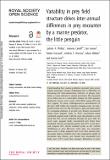Variability in prey field structure drives inter-annual differences in prey encounter by a marine predator, the little penguin
Abstract
Understanding how marine predators encounter prey across patchy landscapes remains challenging due to difficulties in measuring the three-dimensional structure of pelagic prey fields at scales relevant to animal movement. We measured at-sea behaviour of a central-place forager, the little penguin (Eudyptula minor), over 5 years (2015–2019) using GPS and dive loggers. We made contemporaneous measurements of the prey field within the penguins' foraging range via boat-based acoustic surveys. We developed a prey encounter index by comparing estimates of acoustic prey density encountered along actual penguin tracks to those encountered along simulated penguin tracks with the same characteristics as real tracks but that moved randomly through the prey field. In most years, penguin tracks encountered prey better than simulated random movements greater than 99% of the time, and penguin dive depths matched peaks in the vertical distribution of prey. However, when prey was unusually sparse and/or deep, penguins had worse than random prey encounter indices, exhibited dives that mismatched depth of maximum prey density, and females had abnormally low body mass (5.3% lower than average). Reductions in prey encounters owing to decreases in the density or accessibility of prey may ultimately lead to reduced fitness and population declines in central-place foraging marine predators.
Citation
Phillips , L R , Carroll , G , Jonsen , I , Harcourt , R , Brierley , A S , Wilkins , A & Cox , M 2022 , ' Variability in prey field structure drives inter-annual differences in prey encounter by a marine predator, the little penguin ' , Royal Society Open Science , vol. 9 , no. 9 , 220028 . https://doi.org/10.1098/rsos.220028
Publication
Royal Society Open Science
Status
Peer reviewed
ISSN
2054-5703Type
Journal article
Description
This study was funded by Australian Research Council Linkage Grants (grant nos. LP110200603 and LP160100162), with contributions from the Taronga Conservation Society Australia.Collections
Items in the St Andrews Research Repository are protected by copyright, with all rights reserved, unless otherwise indicated.

